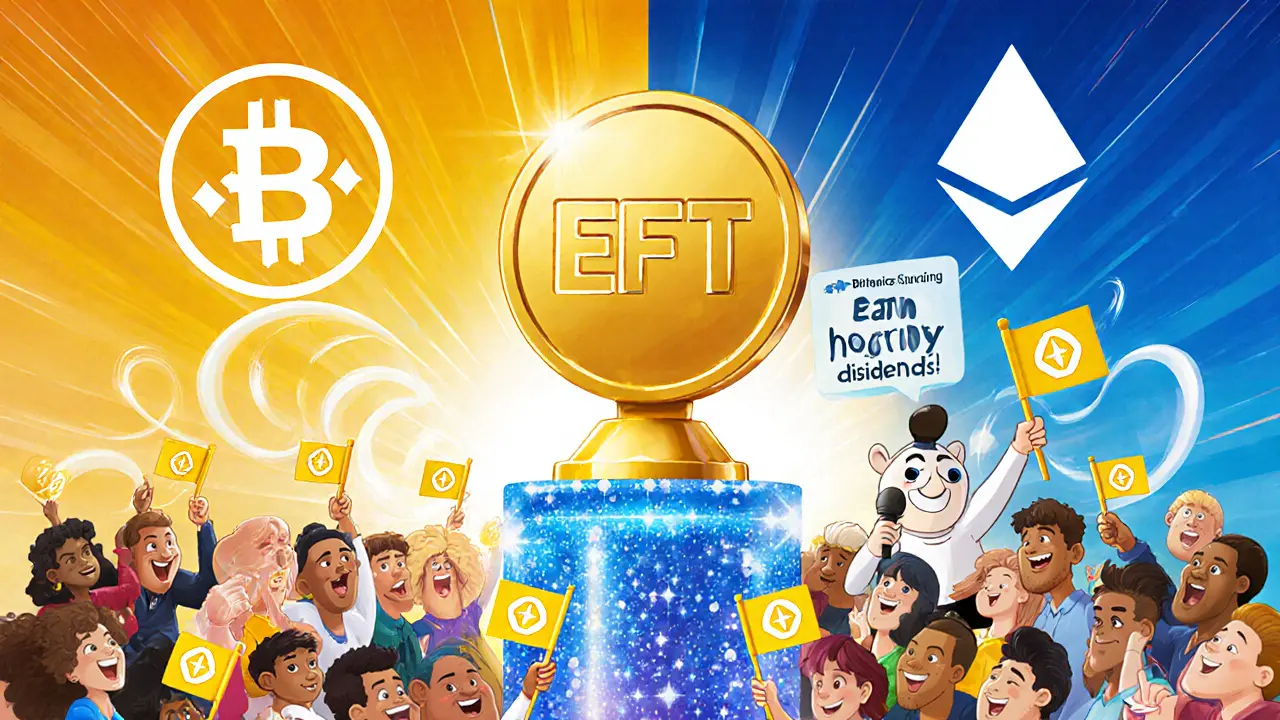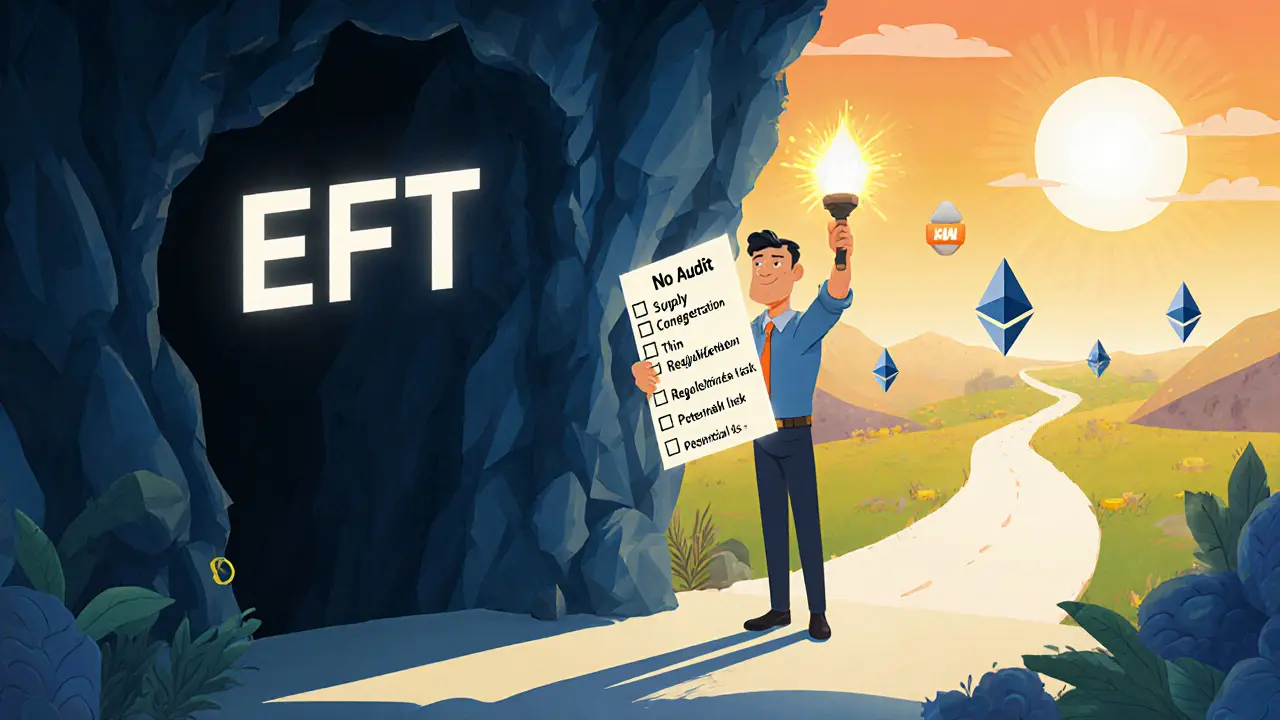 Jun, 6 2025
Jun, 6 2025
EFT Risk & Return Calculator
Estimate the potential returns and risks of holding EFT based on current tokenomics and market conditions.
Results
When you see a token named ETH Fan Token Ecosystem (EFT) is a community‑driven crypto that lives on the Binance Smart Chain (BSC) using the BEP‑20 standard. It promises Ethereum‑related rewards without the high gas fees of the Ethereum network, but the reality is far messier.
Key Takeaways
- EFT runs on BSC, not on Ethereum, and uses a reflection‑type tax to pay hourly dividends in Binance‑Pegged ETH (BETH).
- Market data (Oct 2025) shows a tiny market cap, very low liquidity, and a 24‑hour volume of about $1,800.
- Independent audits are missing; security firms flag EFT as a potential honeypot.
- Most holders report inability to sell, massive price swings, and negligible dividend payouts.
- Overall, EFT is considered a high‑risk speculative token with near‑zero long‑term value.
What EFT Claims to Be
The project’s marketing says it lets small investors earn hourly dividends in BETH simply by holding EFT. The token’s name suggests a link to the Ethereum ecosystem, yet all smart‑contract logic lives on BSC. The team behind EFT remains anonymous, only describing themselves as “a group of individuals … since early 2021.” No audit report, GitHub repo, or verifiable developer identities have ever been published.
Technical Specs and Tokenomics
Below is a snapshot of the core technical data (as of 18 Oct 2025):
| Attribute | EFT (BSC) | Typical Fan Token (BSC) | Ethereum Token (ERC‑20) |
|---|---|---|---|
| Blockchain | BSC (BEP‑20) | BSC (BEP‑20) | Ethereum (ERC‑20) |
| Max Supply | 1 Quadrillion | Varies (usually ≤ 100 B) | Varies (usually ≤ 1 B) |
| Market Cap (Oct 2025) | ≈ BTC 146 (≈ $1.1 M) | ≈ $5‑10 M (average) | ≥ $100 M (most) |
| 24h Volume | $1,821 | $200‑500 K | $10‑50 M |
| Audit Status | Claimed “in process” - no public report | Often audited (e.g., CertiK, PeckShield) | Usually audited |
| Dividend Mechanism | Hourly BETH reflection (tax‑based) | Usually token‑based rewards or voting rights | None or staking rewards via separate contracts |
The token applies a transaction tax that is automatically redistributed to holders as BETH. Exact tax rates differ across wallets and are not consistently disclosed, making it hard to calculate expected yields.

Where to Buy and How to Store EFT
EFT does not appear on major centralized exchanges. You’ll need a BSC‑compatible DEX such as PancakeSwap and a wallet that lets you add custom contract addresses. Supported wallets include MetaMask (set to BSC network), Trust Wallet, and any other BEP‑20 compatible app.
- Set up MetaMask for BSC (rpc: https://bsc-dataseed.binance.org/).
- Import the contract address
0xb72962568345253f71a18318d67e13a282b187e6. - Swap BNB for EFT on PancakeSwap; make sure to set slippage tolerance to at least 15‑25%.
- After purchase, keep the token in a non‑custodial wallet; do NOT store it on unverified centralized platforms.
Because the token’s liquidity is thin, you’ll often face a 15‑30% price impact and occasionally “transaction reverted” errors that many users label as honeypot behavior.
Performance and Market Data (Oct 2025)
CoinMarketCap ranks EFT at #5247, reflecting an almost negligible market cap. The fully diluted valuation (FDV) is BTC 146.06 (≈ $1.1 M). Trading volume sits at $1,821 over 24 hours, giving a volume‑to‑market‑cap ratio above 120 %-a pattern seen in manipulated micro‑cap tokens.
Price moved +33.9 % over a 7‑day window in mid‑October, but that gain came amid virtually flat broader market conditions and appears driven by coordinated whale activity rather than organic demand.
Holder distribution is heavily skewed: 92.7 % of liquid supply resides in the top 10 wallets, and total unique holders dropped from 3,175 in July to 1,842 on 18 Oct 2025.
Red Flags and Community Feedback
Multiple independent analyses flag EFT as high‑risk:
- CertiK listed EFT among tokens with honeypot characteristics (Sept 2025 report).
- BeInCrypto warned of classic pump‑and‑dump price patterns and whale‑controlled supply (Oct 10 2025).
- Benjamin Cowen called it “speculative micro‑cap with near‑zero fundamental value” (Oct 5 2025).
Reddit users report losing $300‑$400 when trying to sell, with transactions failing despite sufficient balance. Trustpilot shows a 1.2/5 average rating, citing impossible withdrawals and silent admins.
Telegram activity has plummeted: membership fell 63 % since July, and moderator response times grew from 2 hours to 72 hours.

Comparing EFT to Legitimate Ethereum Tokens
Legitimate Ethereum‑related tokens such as Lido’s stETH or Rocket Pool’s RPL have multi‑billion market caps, audited smart contracts, and transparent development roadmaps. They earn rewards through staking or protocol fees, not through opaque reflection taxes.
In contrast, EFT offers no real integration with Ethereum’s core infrastructure. The “hourly dividend” is merely a redistribution of BETH that the token itself receives from transaction fees-essentially a zero‑sum game.
Is EFT a Viable Investment?
Putting the pieces together, the answer leans heavily toward “no.” The token suffers from:
- Extremely low liquidity and high price impact.
- Concentration of supply in a few wallets, inviting pump‑and‑dump schemes.
- Lack of verifiable audit or open‑source code.
- Negligible dividend yields (≈ 0.0025 % APR reported by a user survey).
- Regulatory risk: the SEC has warned that hourly‑dividend tokens may be securities violations.
For a retail investor seeking exposure to Ethereum, buying actual ETH on a reputable exchange or staking ETH through a reputable platform is far safer and more cost‑effective than buying EFT.
Quick Checklist Before You Touch EFT
- Can you verify the smart‑contract code? (No public repo available.)
- Do you understand the tax‑and‑reflect mechanism? (Rates are unclear.)
- Is there any audited security report? (None published.)
- Are you prepared to lose the entire investment? (High failure probability.)
- Do you have a reliable BSC wallet and know how to set slippage?
If you answer “no” to more than one of these, walk away.
What blockchain does EFT run on?
EFT is built on the Binance Smart Chain (BSC) and follows the BEP‑20 token standard.
Can I earn real Ethereum by holding EFT?
EFT rewards holders with Binance‑Pegged ETH (BETH), not with native Ethereum. The dividends come from transaction fees, not from staking actual ETH.
Is EFT audited?
The project claims an audit is “in process,” but no public audit report from a recognized firm has been released.
How liquid is EFT on decentralized exchanges?
Liquidity is very thin; price impact often exceeds 15 % and spreads can be wider than 30 % on PancakeSwap.
What are the main risks of investing in EFT?
Key risks include potential honeypot behavior, lack of audit, extreme supply concentration, regulatory scrutiny, and the chance of total loss.
Scott McCalman
June 6, 2025 AT 23:00Look, the EFT token markets itself as a “fan token” but underneath it’s just a classic BSC tax‑swap scheme – every buy or sell gets siphoned off as a hidden fee, then redistributed as BETH, which is basically a zero‑sum game. 🎭 The reflection mechanism looks shiny on paper, yet anyone who’s ever skimmed a BSC honeypot knows the pain of trying to cash out. The tax rates even change per wallet, so you can’t reliably calculate yields. If you’re hoping for “hourly dividends,” brace yourself for a roller‑coaster that never actually pays anything meaningful. 😅
PRIYA KUMARI
June 13, 2025 AT 22:03Stop buying the hype. This token is a textbook honeypot, and the so‑called “dividends” are nothing more than a smokescreen for rug pulls. The devs are anonymous for a reason – they have nothing to lose but your money. Anyone still considering EFT is either clueless or willfully blind, and that’s unacceptable.
Jessica Pence
June 20, 2025 AT 21:00If you decide to inspect the contract, head over to BscScan and look for the “Contract Source Code” tab – it should be verified. If it isn’t, that’s a red flag. Also, double‑check the token’s actual liquidity pool on PancakeSwap; a thin pool means you’ll get slippage like crazy. Lastly, keep an eye on the tax percentages – they’re often hidden in the contract’s fallback function, so don’t trust the UI alone. (Sorry for any typo, I’m typing fast!)
johnny garcia
June 27, 2025 AT 19:56Indeed, a thorough on‑chain audit is indispensable when confronting opaque tokenomics. The philosophical underpinnings of financial trust dictate that transparency precedes participation; without verified source code, we cannot ascertain the integrity of the reflection mechanism. 🧭 Moreover, the asymmetry in tax allocation underscores a fundamental breach of the social contract between issuer and holder. In light of these considerations, prudence advises abstention from EFT.
Andrew Smith
July 4, 2025 AT 18:53Hey folks, I get the curiosity about EFT, but honestly the risk‑reward ratio just isn’t worth it. Stick with proven assets like ETH itself or reputable staking platforms. There’s no shame in walking away from a sketchy micro‑cap – your portfolio will thank you later.
Ryan Comers
July 11, 2025 AT 17:50Are you kidding me? Your “safe” advice is just another bland echo from the mainstream media trying to keep us all in line. Real investors dive into the wild, they sniff out those hidden gems before the whales swing the market. EFT’s low liquidity is a feature, not a bug – it’s an opportunity for the bold.
Prerna Sahrawat
July 18, 2025 AT 16:46When one embarks upon an analytical exegesis of the ETH Fan Token Ecosystem (EFT), it becomes increasingly evident that the superficial veneer of “community‑driven” ambition merely conceals a labyrinthine architecture of fiscal extraction and tokenomic opacity. The very nomenclature, invoking the illustrious Ethereum brand, is an exercise in semiotic misdirection, designed to engender a cognitive bias whereby investors conflate brand equity with intrinsic value. Moreover, the deployment of a BEP‑20 substrate on Binance Smart Chain introduces an additional stratum of cross‑chain dissonance, rendering any purported “Ethereum‑related” dividends effectively illusory. The reflection‑type tax, whose rate fluctuates capriciously across disparate wallet addresses, fortifies a pernicious feedback loop, wherein each transaction siphons a fraction of capital back into the contract, yet distributes a negligible portion as BETH, thereby eroding net returns. Empirical data from October 2025 underscores a market capitalization hovering near a mere $1.1 million, juxtaposed against a liquidity depth that precipitates price impacts exceeding twenty percent on modest trades. Such a market microstructure is emblematic of a manipulation‑prone environment, wherein a handful of wallets command upwards of ninety‑two percent of the circulating supply, thereby granting them unilateral influence over price trajectories. The absence of an independent audit, coupled with the enumeration of the token as a potential honeypot by reputable security firms, amplifies the specter of systemic risk. From a regulatory perspective, the token’s hourly dividend mechanism may well be construed as a securities offering, exposing participants to juridical jeopardy. In the broader ecosystemic context, legitimate Ethereum‑based derivatives such as stETH or RPL epitomize rigorously audited, transparent, and sustainably incentivized constructs, starkly contrasting the speculative volatility besetting EFT. Consequently, the rational investor, equipped with due diligence, is compelled to eschew participation in a venture whose fundamental attributes contravene the tenets of sound financial stewardship. The prudent course of action entails a decisive withdrawal from EFT, reallocating capital toward assets underpinned by verifiable code, robust liquidity, and demonstrable utility. Only through such disciplined allocation can one safeguard against the erosive forces that pervade micro‑cap tokens of this ilk. Investors should also monitor community signals such as sudden drops in Telegram activity, which often presage exit scams. Ultimately, the onus lies on the individual to eschew allure and prioritize fiscal prudence.
Joy Garcia
July 25, 2025 AT 15:43Reading your dissertation feels like watching a state‑sponsored propaganda piece; the real story is that shadowy actors manipulate tokens like EFT to launder proceeds, and the “audit in process” is just a smokescreen to keep regulators at bay. The sudden silence in their Telegram channels isn’t a coincidence – it’s a coordinated blackout when the insiders pull the rug.
mike ballard
August 1, 2025 AT 14:40From a DeFi protocol architecture standpoint, EFT exemplifies a low‑liquidity, high‑tax token pair whose slippage vector skews dramatically under load, leading to price dislocation and impermanent loss for LPs. 🚀 Tokenomics 2.0, but really just a classic fee‑grabber on BSC.
Molly van der Schee
August 8, 2025 AT 13:36I hear you, and I’d add that newcomers should always verify contract source before staking any LP tokens. Staying informed can save a lot of headaches later.
Mike Cristobal
August 15, 2025 AT 12:33Stay away from EFT.
Erik Shear
August 22, 2025 AT 11:30Exactly. No point risking hard‑earned cash.
Tom Glynn
August 29, 2025 AT 10:26Hey everyone, remember that diversification is key – spreading risk across multiple assets protects you from the inevitable failures like EFT. 🌱 Keep learning, stay curious, and never put all your eggs in one volatile basket.
Johanna Hegewald
September 5, 2025 AT 09:23Good advice. I’ll stick to big coins.
Benjamin Debrick
September 12, 2025 AT 08:20In the grand tapestry of decentralized finance, wherein each token is but a filament woven into the expansive, inter‑connected mesh of blockchain innovation, one must, with due diligence, interrogate not merely the superficial allure of projected yields, but also the underlying structural integrity, code audit provenance, and liquidity robustness; otherwise, the investor courts a precarious destiny, flirted upon by the capricious whims of market manipulators; thus, prudence dictates an unwavering vigilance, an unrelenting quest for transparency, and a steadfast commitment to evidence‑based participation, lest one be ensnared by the seductive, yet treacherous, siren song of micro‑cap speculation.
Anna Kammerer
September 17, 2025 AT 23:00Oh sure, because nothing says “smart investing” like diving headfirst into a token that even the auditors can’t find. 🙄